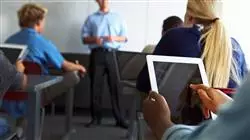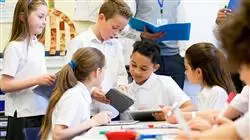University certificate
The world's largest school of languages”
Introduction to the Program
Develop new communication skills and adapt your teaching methods to the digital age with this prestigious program"

This training will allow you to develop and expand your knowledge and skills related to Spanish lexical competence in teaching. At the end of the Postgraduate Diploma, the professionals will be able to detect frequent errors in teaching Spanish and will have acquired the necessary tools for the prevention and correction of these errors, so that they will have the necessary skills to work as a teacher of Spanish as a foreign language.
All of this, taking into consideration that teaching is a discipline that must advance at the same pace as technological advances. For that reason, this program has been designed for the teacher to be trained with the latest educational technology to discover every aspect of digital learning.
Digital teaching, applied to language teaching, is an invaluable resource. This program will allow to know and understand how to apply the most useful and stimulating digital tools in this field. A high-level training course in which you will acquire a practical vision of the use of the latest technological advances applied to language teaching, expanding your professional skills in an efficient and dynamic way.
This Postgraduate Diploma will provide teachers with the tools and knowledge necessary to practice their profession with confidence and efficiency, enabling them to help their students to understand and analyze messages effectively, and to develop non-verbal communication.
With a methodological design that relies on teaching techniques distinguished by their effectiveness, this Postgraduate diploma will take you through different teaching approaches to allow you to learn in a dynamic and effective way"
This Postgraduate diploma in Teaching Strategies and Technological Innovation in Foreign Language Learning Learning contains the most complete and up-to-date educational program. The most important features include:
- The latest technology in online teaching software
- Intensely visual teaching system, supported by graphic and schematic contents, easy to assimilate and understand
- Practical cases presented by practising experts
- State-of-the-art interactive video systems
- Teaching supported by telepractice
- Continuous updating and recycling systems
- Autonomous learning: full compatibility with other occupations
- Practical exercises for self-assessment and learning verification
- Support groups and educational synergies: questions to the expert, debate and knowledge forums
- Communication with the teacher and individual reflection work
- Content that is accessible from any fixed or portable device with an internet connection
- Supplementary documentation databases are permanently available, even after the program
With an educational approach based on the resolution of real situations, this Postgraduate diploma will allow you to apply what you have learned in your daily teaching practice, immediately and with total confidence"
The teaching staff includes teaching professionals, who bring their experience to this training program, as well as renowned specialists belonging to leading societies and prestigious universities.
Its multimedia content developed with the latest educational technology, will allow the professional a situated and contextual learning, that is, a simulated environment that will provide an immersive learning programmed to train in real situations.
This program is designed around Problem-Based Learning, whereby the educator must try to solve the different professional practice situations that arise throughout the program. For this purpose, the professional will be assisted by an innovative interactive video system developed by recognized experts in the field of teaching.
Prominent experts in the field have meticulously designed this Postgraduate diploma, bringing all their experience and knowledge to bear in its preparation"

Our innovative telepractice concept will provide you with a faster learning process and a much more realistic view of the contents"
Structure and content
The contents of this Postgraduate diploma have been developed by the different experts on this program, with a clear purpose: to ensure that our students acquire each and every one of the necessary skills to become true experts in this field.
A complete and well-structured program will take you to the highest standards of quality and success.

Get trained wherever and whenever you want, thanks to the online mode of this Postgraduate diploma that allows you to take this training from any electronic device with an Internet connection"
Module 1. Didactics of Lexical-Semantics
1.1. Introduction to Lexical Semantics
1.1.1. Historical Precedents
1.1.2. Significance
1.1.3. Signs and Symbols
1.1.4. Linguistic Communication
1.1.5. The Linguistic Sign
1.2. Fundamentals
1.2.1. What is Semantics?
1.2.2. Semantics. Is it a Science?
1.2.3. Structural Semantics
1.2.4. Semantics and Society
1.3. Learning and Acquisition
1.3.1. Basic Principles
1.3.2. Pedagogical Methods
1.3.3. Evolutionary Development
1.3.4. Difficulties
1.4. Production and Creation
1.4.1. Spanish Lexicon
1.4.2. Classification of the Lexicon
1.4.3. Word Formation
1.4.4. Semantic Phenomena
1.5. Lexical/Semantic Application
1.5.1. The Need for Explicit Lexicon Teaching
1.5.2. Lexematic
1.6. Active Learning
1.6.1. What Is It?
1.6.2. Pedagogical Model
1.6.3. Importance of Active Learning
1.6.4. Teaching Tools
1.7. Dictionaries
1.7.1. Typology
1.7.2. The Selection Process
1.7.3. The Dictionary as a Pedagogical Resource
1.7.4. Learning Tool
1.7.5. Resources and Strategies
Module 2. Oral and Written Skills: Teaching Strategies
2.1. Introduction to Communicative Skills
2.2. Educational Skills in the Spanish as a Foreign Language Classroom
2.2.1. Communicating as a Means of Information
2.3. Types of Skills
2.3.1. Skills within the Educational Framework
2.3.2. Cognitive Skills
2.3.3. Intrinsic Value Tasks
2.4. Explanation of Semantic Skills
2.4.1. Understanding the Reality of the Classroom
2.4.2. Language as an Object of Observation and Analysis
2.4.3. Knowledge and Effective Application of Linguistic Rules
2.5. Sociocultural Context and Language Use: Sociolinguistic Competence
2.5.1. Vocabulary according to the Type of Culture
2.5.2. Influence of Advertising on the Linguistic Shape of Culture
2.6. Conversation: Pragmatic Competence
2.6.1. Communicative Competence as a Learning Goal
2.6.2. Discourse Competence by Context
2.7. Forms of Politeness Derived from Pragmatic Competence
2.7.1. Sequence and Macrocontext
2.7.2. Overall Discursive Intent
2.8. Non-Verbal Language in Gestural Communication
2.8.1. Positioning, Gestures, Gaze and Mimicry
2.8.1.1. Factors Associated with Non-Verbal Language
2.9. Reading and Writing Comprehension
2.9.1. Comprehensive Analysis of Reading and Writing
2.10. Listening Comprehension
2.10.1. Comprehensive Analysis of Listening and Speaking Tasks
2.11. CEFR and Teaching Spanish as a Foreign Language: Reading Comprehension in the Spanish as a Foreign Language Classroom
2.11.1. Literature to Learn Language or to Learn Literature
2.11.2. Common European Framework (CEFR) and Reading Comprehension Guidelines
2.12. CEFR and Teaching Spanish as a Foreign Language: Listening Comprehension in the Spanish as a Foreign Language Classroom
2.12.1. Analysis of Types of Skills to Be Developed in Listening Comprehension
2.13. CEFR and Teaching Spanish as a Foreign Language: Oral Comprehension in the Spanish as a Foreign Language Classroom
2.13.1. Speech as a Means of Making Yourself Understood
2.14. CEFR and Teaching Spanish as a Foreign Language: Written Comprehension in the Spanish as a Foreign Language Classroom
2.14.1. The Dissociation between Written Comprehension and Written Creation
2.15. Skills Assessment: Speaking and Listening Context
2.15.1. How to Evaluate Speaking and Listening Depending on the Classroom Context and Prevailing Culture?
2.16. Skills Assessment: Reading and Writing Context
2.16.1. How to Evaluate Reading and Writing Depending on the Classroom Context and Prevailing Culture?
Module 3. Technological Innovation in Teaching
3.1. Advantages and Disadvantages of the Use of Technology in Education
3.1.1. Technology as a Means of Education
3.1.2. Advantages of Use
3.1.3. Inconveniences and Addictions
3.2. Educational Neurotechnology
3.2.1. Neuroscience
3.2.2. Neurotechnology
3.3. Programming in Education
3.3.1. Benefits of Programming in Education
3.3.2. Scratch Platform
3.3.3. Confection of the First Hello World
3.3.4. Commands, Parameters and Events
3.3.5. Export of Projects
3.4. Introduction to the Flipped Classroom
3.4.1. On What is the Flipped Classroom Based?
3.4.2. Examples of use
3.4.3. Video Recording
3.4.4. YouTube
3.5. Introduction to Gamification
3.5.1. What is Gamification?
3.5.2. Success Stories
3.6. Introduction to Robotics
3.6.1. The Importance of Robotics in Education
3.6.2. Arduino (Hardware)
3.6.3. Arduino (Programming Language)
3.7. Tips and Examples of Use in the Classroom
3.7.1. Combining Innovation Tools in the Classroom
3.7.2. Real Examples
3.8. Introduction to Augmented Reality
3.8.1. What is Augmented Reality?
3.8.2. What are the Benefits in Education?
3.9. How to Develop Your Own Apps in AR
3.9.1.Vuforia
3.9.2. Unity
3.9.3. Examples of use
3.10. Samsung Virtual School Suitcase
3.10.1. Immersive Learning
3.10.2. The Backpack of the Future

This will provide key training to advance your career"
Postgraduate Diploma in Teaching Strategies and Technological Innovation in Foreign Language Learning
The Postgraduate Diploma in Teaching Strategies and Technological Innovation in Foreign Language Learning is an opportunity for teachers to update themselves on the latest educational trends in the field of language teaching. Technology has become an indispensable ally for language teachers, and this program gives them the opportunity to acquire the necessary skills to apply it effectively in the classroom.The use of new teaching and technological strategies in foreign language teaching can make a difference in students' academic performance. This program offers a complete specialization in the application of digital tools and multimedia resources to improve the learning process of students. Education professionals who complete this Postgraduate Certificate will be able to effectively integrate technology into their classrooms and achieve positive results in their students' performance.
Update your knowledge in Foreign Language Pedagogy
The Postgraduate Diploma in Teaching Strategies and Technological Innovation in Foreign Language Learning is a 100% online program, designed so that teachers can update their knowledge and skills from anywhere and at any time. With highly specialized faculty, participants will have access to quality teaching that will allow them to develop professionally and differentiate themselves in the field of language teaching.In short, this program is a unique opportunity for foreign language teachers to update themselves on the latest educational trends and acquire the necessary skills to apply them in the classroom. With a thorough preparation in teaching strategies and technological innovation, participants will be better prepared to face the challenges of language teaching in the digital era and obtain better academic results for their students.







